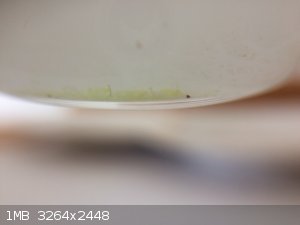Keras
National Hazard
   
Posts: 774
Registered: 20-8-2018
Location: (48, 2)
Member Is Offline
|
|
Sodium thiosulphate + bleach → colloidal sulphur
Folks,
according to Wikipedia, sodium thiosulphate mixed with bleach should produce sodium sulphate, salt and water.
I tried that this morning, and instead got a lot of free colloidal sulphur, which normally should not happen unless the solution is acidic. Not the
case here.
The colloidal sulphur clouds the solution and then settles at the bottom of the beaker where it can be scraped to form small sulphur crumbs (picture).
Any idea what reaction is at stake here? Just curious, tbh, nothing vital.

|
|
|
woelen
Super Administrator
        
Posts: 7977
Registered: 20-8-2005
Location: Netherlands
Member Is Offline
Mood: interested
|
|
It is a redox reaction. The page on Wikipedia gives a strongly simplified description of the reaction.
Thiosulfate can be decomposed by acid, by forming H2S2O3, which in turns decomposes to H2SO3 (and then to H2O and SO2) and free sulfur.
With strong oxidizers, many different reactions can occur. Thiosulfate can be oxidized to tetrathionate, the S4O6(2-) ion, to elemental sulfur and
sulfate, to sulfite, to sulfite and sulfate, and to only sulfate. The latter is the most extreme oxidation, then there is complete oxidation. All
others are intermediate stages of oxidation. If you use a large excess of bleach and if you give the reaction a lot of time, then all thiosulfate
might end up as sulfate, but this reaction almost certainly goes through other stages.
One possible reaction could be:
S2O3(2-) + OCl(-) --> SO4(2-) + S + Cl(-) (here I write S, better is to write S8, and multiply all other coefficients by a factor 8).
The sulfur in turn can be further oxidized by addition of more oxygen atoms). Some of these redox-reactions also affect pH, due to consumption or
production of H(+) ions. So, all in all, the reaction can be very complicated and one cannot write a simple reaction equation, which covers it
completely.
|
|
|
Keras
National Hazard
   
Posts: 774
Registered: 20-8-2018
Location: (48, 2)
Member Is Offline
|
|
Yeah, I imagined that. It was nice seeing the cloud of colloidal sulphur grow steadily from the thiosulphate crystal as it dissolved into the bleach
solution. To be honest, aesthetically, I’m more satisfied with this colloidal sulphur than sulphate.
I was testing the ability to improve the taste of tap water, when it happens to be heavily treated with bleach. Now I didn't dare drink the resulting
product, but I will prolly renew the experience with real tap water one day.
I thought I could use thiosulphate to reduce Cr(III) to Cr(0), but it seems that’s not really possible (unless I've not found the right redox
couple)
|
|
|
woelen
Super Administrator
        
Posts: 7977
Registered: 20-8-2005
Location: Netherlands
Member Is Offline
Mood: interested
|
|
No, reducing Cr(III) to Cr(0) in aqueous solution requires extreme reductors. Even zinc does not accomplish that, with zinc you get a Cr(II) solution
at low pH (sky blue color) and at too high pH nothing happens.
Thiosulfate is only a mild reductor.
|
|
|
macckone
International Hazard
    
Posts: 2159
Registered: 1-3-2013
Location: Over a mile high
Member Is Offline
Mood: Electrical
|
|
thiosulfate will reduce Cr(VI) to Cr(III) though, which is useful since the +6 valence is known to tear up cells and dna.
|
|
|